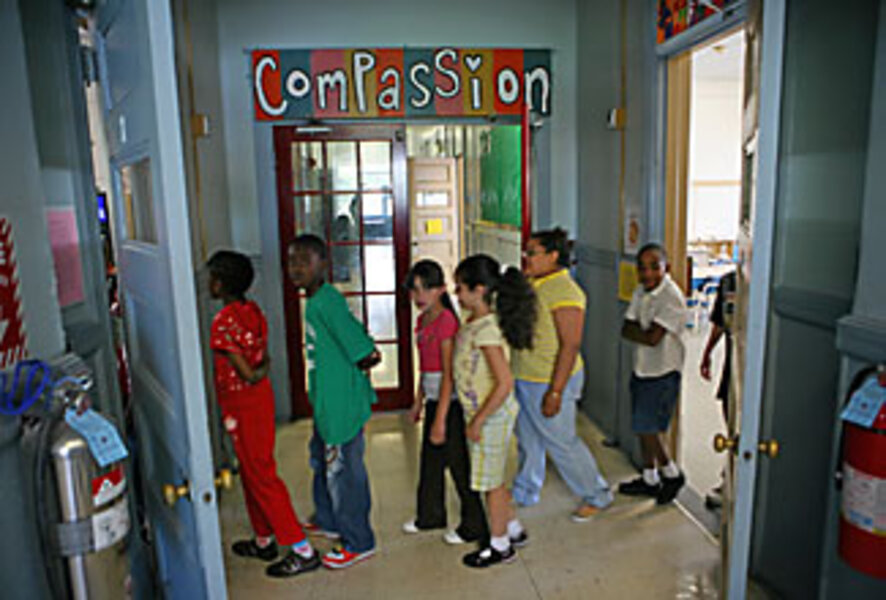Across U.S., schools feel budget pinch
| Lynn, Mass.
The Fallon elementary school is a joyous place. But last week, some parents, students, and staff felt as blue as the hallway walls. On Friday, the small school in Lynn, Mass., shut its doors – not just for the summer, but for good.
In districts across the United States, budget shortfalls are resulting in locked-up schools, flurries of pink slips, and empty shelves where new books and computers should be. In cities from Los Angeles to Detroit, and in rural towns from Louisiana to New Hampshire, schools, like other sectors, are caught between skyrocketing prices and dried-up funding streams.
"You have the perfect storm forming," says Chuck Essigs, director of government relations for the Arizona Association of School Business Officials. "You have costs going up ... for energy and fuel and health insurance ...
and a loss of revenue from the state. [That is] creating certainly a lot more of a challenge than school districts have faced in many, many years."
Twenty-nine states are facing a total of about $48 billion in overall shortfalls for fiscal year 2009, nearly a 10 percent drop, according to the Center on Budget and Policy Priorities in Washington, and education will bear some of the burden.
California, Arizona, and Florida are among the hardest hit (down 21 percent, 18 percent, and 11 percent, respectively). Conditions could worsen, the National Governors Association predicts, since states tend to feel the pinch for a while after economic recovery begins. For some areas, the declining housing market will bite into local revenues as well.
Like the downturn of the early 1990s and the period following the 9/11 attacks, "it's going to be a very lean couple years," says Paul Houston, executive director of the American Association of School Administrators in Arlington, Va. "As a superintendent, you're trying to figure out, 'Where are the edges? Where can I do this [cutting] that's going to have the least impact?' "
With fuel costs, a four-day week?
Miami-Dade County Public Schools are taking measures to cut $284 million, about 10 percent of their current budget, says spokesman John Schuster. Health insurance costs are going up about $36 million, electricity $16 million, and bus fuel nearly tripled to a projected $16 million for next year. Funding from the state dropped by $69 million.
Out of 50,000 employees, about 2,000 positions are being cut, half of them teachers, though Mr. Schuster says some teachers should be able to find places in schools where there's attrition. Teachers protested this weekend a proposal to save nearly $48 million by withholding raises.
"I've been with the district for about 20 years, and in talking with all of the old-timers this is probably the toughest season we have seen," Schuster says.
Education has been losing out in the federal budget as well. The Urban Institute reported last week that federal education spending in real terms for fiscal year 2007 was down 2.1 percent from 2006.
The road is particularly hard in areas with declining enrollments. Much of education funding is distributed per pupil, but costs don't necessarily go down in the same proportion as the population drops.
The Mesa, Ariz., schools, for example, educate 72,000 children, down 1,500 from a year ago. They recently hammered out about $13 million in cuts, or three percent of their operating budget. In addition, they anticipate increased costs such as $4 million for bus fuel, up from $3.1 million this school year.
A registered nurse will now oversee paraprofessionals in the schools, instead of each school having a nurse. Libraries will no longer be staffed with certified teachers. Offices and custodian crews will slim down. The good news is the district will maintain its student-teacher ratio and its art, music, and physical education programs.
"We are the largest employer in our city," says Mesa schools spokeswoman Kathy Bareiss, "and we wanted to be sure we implemented these cuts over a three-year period so that we weren't releasing people [all at once] into the job market."
Fuel costs have prompted more districts to consider shifting to a four-day week, particularly in rural areas. When school starts up in Caldwell Parish, La., classes will run Tuesday through Friday until 4:25 p.m., for a savings of up to $140,000.
Expensive transport is also contributing to the price of school lunches. Since April, the School Nutrition Association has found that about 100 districts a month have been raising lunch prices by roughly 15 to 25 cents. Students who get free or reduced-price meals aren't affected.
But when the federal government announces an increase in the reimbursement rate to schools in July, "it's probably not going to be enough to keep up with what [schools] are feeling," says association spokeswoman Alexis Steines.
In Lynn, a small school closes
In Lynn, a city north of Boston that's home to many immigrant families, the district's business manager recently had to transfer $200,000 from other parts of the budget to cover food costs.
As the first- and second-graders at the Fallon school sip their milk in the basement cafeteria, Principal Stanley "Lenny" Serwacki offers a wry joke out of their earshot, "This is their last lunch – their Last Supper!"
It's a bittersweet time for him. After 36 years as an educator, he's retiring – a plan he made before finding out a few weeks ago that the school was slated for closure. "I was hoping to pass the torch on to somebody else so they could experience this fabulous place," he says, clutching a scrapbook the fourth-graders gave him. Instead, he had to pass around tissues, and hold back his own tears, at this morning's final fifth-grade graduation.
Ana Arruda's daughter, Sabrina, was among the graduates, and her son, Matthew, just finished second grade. "We were extremely sad," Ms. Arruda says, "because he wouldn't get the chance to have what she had" – a close-knit community and a level of attention from teachers they might not find in larger schools.
The Lynn district opted to close two schools with small enrollments to find the lion's share of the $6.4 million it needed to cut for next year – a 5.6 percent trim off the $114.4 million it would have had to pay for the same level of services that it had this year. The teaching staff will be down by 116.
The new maximum class size should be 29, up from 25, but most classes will continue to be smaller, says Mayor and School Committee Chairman Edward "Chip" Clancy. The schools received $500,000 more than last year from the city, the only city department to receive an increase, he says, but that wasn't enough to keep up with rising costs.
With a state cap on taxes and a strong collective-bargaining law, he says, times are lean for school districts all over Massachusetts.
The future for teachers
That's one reason teacher Levonne Coughlin is considering giving up the profession she loves. As a third-grade teacher at Fallon with only three years in the Lynn system, she wasn't senior enough to ward off a pink slip. Some teachers may get called back by the fall, but she's not counting on it. And this isn't the first time she's been laid off.
"I need job security," the mother of two says as she takes a break from a final spelling bee with her class. She worries that kids at the high end and the low end of the academic spectrum will lose out as classes get larger. And with other districts facing similar cuts, she says, "I worry about the future of teaching altogether."







